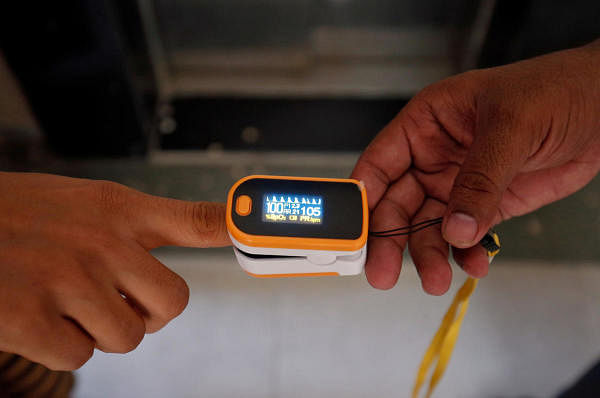
After swab testing methods and rapid antigen tests for months-long periods to indicate the presence of Covid-19 in a human being, a new technique to determine the likelihood of a positive case has been found. The Pulse oximeter is solely used to determine the pulse rate and oxygen flow in the body, and does not function as a substitute for a coronavirus test.
Here's all you need to know about the Pulse Oximeter:
What is the Pulse Oximeter?
The Pulse Oximeter is a small-sized lightweight device that employs a non-invasive and painless mechanism to measure the amount of oxygen levels in the blood. It can be clipped on to a fingertip, toe or earlobe to rapidly detect the flow of oxygen in the human system. The device is used in cases of chronic obstructive pulmonary disease (COPD), asthma, pneumonia, lung cancer, anemia and even during heart attacks or heart failures.
How does a Pulse Oximeter work?
The Pulse Oximeter must be attached to a body part (generally a fingertip). It passes small beams - two wavelengths - of light through the body to evaluate how efficiently oxygen is carried to the extremities furthest from the heart, including the legs and the arms. The reading is obtained by the measurement of changes of light absorption in oxygenated or deoxygenated blood.
According to the World Health Organisation's Pulse Oximetry Training Manual, the process takes about 10-12 seconds to obtain an accurate reading of the oxygen levels. The screen displays the percentage of oxygen in the blood that is pumped from the heart. In addition, the pulse rate is recorded as beats per minute.
Apart from determining oxygen-levels and pulse rate, what is the Pule Oximeter used for?
The Pulse Oximeter can detect minute changes in the oxygen levels, hence, it is also used to assess the progress of lung medications, to evaluate the helpfulness of a ventilator, to monitor change in oxygen levels prior-, during- and post-surgical procedures, to determine the efficiency of supplemental oxygen therapy, to assess one's tolerance to increased physical activity, etc. It can also be used to keep a continuous check on those who suffer from sleep apnea.
How has the Pulse Oximeter become a coronavirus necessity?
Persons infected by the coronavirus disease experience mild to moderate respiratory illness. The device detects hypoxemia or low blood oxygen levels, which is one of the early signs of coronavirus infection. It is, thus, beneficial to those who develop a mild cough or throat itch, as they can then proceed to get tested and quarantine themselves to curb further spread of the virus.
Can the Pulse Oximeter be a coronavirus-test substitute?
No, the Pulse Oximeter only detects a change in the oxygen levels and cannot prove the presence of the Covid-19 disease in a human body.
It is important to note that oxygen values in the bloodstream are dependent on multiple factors such as health conditions, respiratory rate, percentage of oxygen in the air etc. Smoking, vaping and intake of other substances also affect the oximeter reading as these activities affect the lung capacity to send oxygen to the blood.
(Inputs from agencies and news reports)